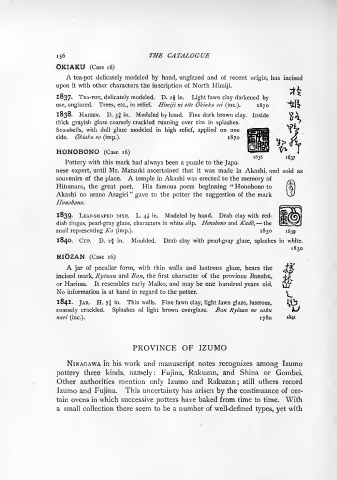Page 234 - Catalogue of the Edward Morse collection of Japanese pottery MFA BOSTON
P. 234
156 THE CATALOGUE
OKIAKU (Case 16)
A tea-pot delicately modeled by hand, unglazed and of recent origin, has incised
upon it with other characters the inscription of North Himiji.
1837- Tea-pot, delicately modeled. D. i\ in. Light fawn clay darkened by
use, unglazed. Trees, etc., in relief, Himiji ni oite Okiaku sei (inc.). 1870
1838. Haisen. D. 5} in. Modeled by hand. Fine dark brown clay, Inside
thick grayish glaze coarsely crackled running over rim in splashes.
Sea-shells, with dull glaze modeled in high relief, applied on one
side. Okiaku ro (imp.). 1870
HONOBONO (Case 16)
Pottery with this mark had always been a puzzle to the Japa-
nese expert, until Mr. Matsuki ascertained that it was made in Akashi, and sold as
souvenirs of the place. A temple in Akashi was erected to the memory of
Hitomaro, the great poet. His famous poem beginning " Honobono to
Akashi no urano Asagiri " gave to the potter the suggestion of the mark
Honobono.
1839. Leaf-shaped dish. L. 4J in. Modeled by hand. Drab clay with red-
dish tinges, pearl-gray glaze, characters in white slip. Honobono and Kado, — the
snail representing Ka (imp.). 1830
1840. Cup. D. 2| in. Moulded. Drab clay with pearl-gray glaze, splashes in white.
1830
RIOZAN (Case 16)
M
A jar of peculiar form, with thin walls and lustrous glaze, bears the
incised mark, Rydzan and Ban, the first character of the province Banshu,
or Harima It resembles early Maiko, and may be one hundred years old.
No information is at hand in regard to the potter.
1841. Jar. H. 75 in. Thin walls. Fine fawn clay, light fawn glaze, lustrous,
coarsely crackled. Splashes of light brown overglaze. Ban Rydzan no saku
nari {inc.). 1780 184X
PROVINCE OF IZUMO
NiNAGAWA in his work and manuscript notes recognizes among Izumo
pottery three kinds, namely: Fujina, Rakuzan, and Shina or Gombei.
still others record
Other authorities mention only Izumo and Rakuzan ;
Izumo and Fujina. This uncertainty has arisen by the continuance of cer-
tain ovens in which successive potters have baked from time to time. With
a small collection there seem to be a number of well-defined types, yet with

